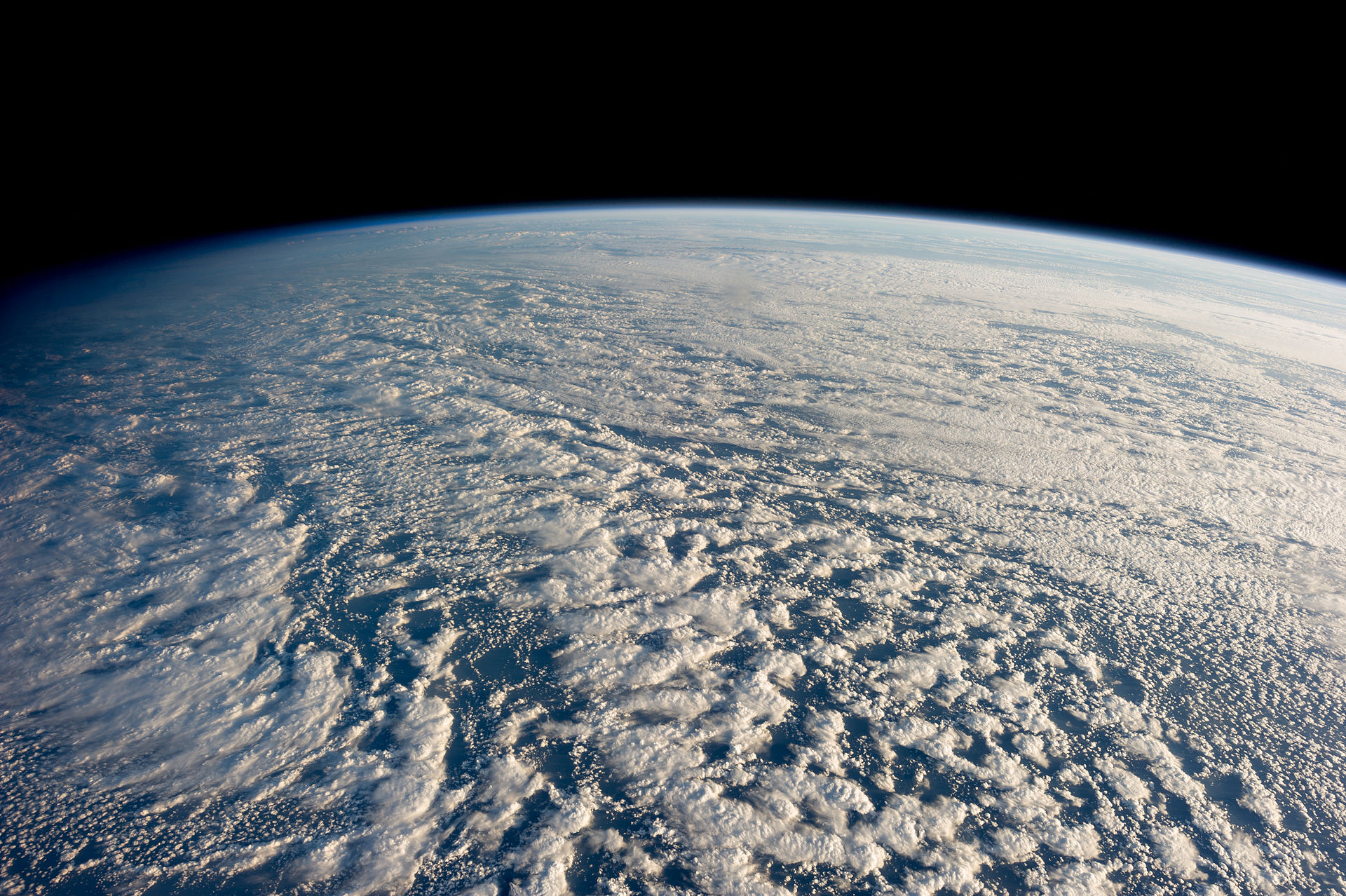
Stratocumulus clouds above the northwestern Pacific Ocean, about 460 miles east of northern Honshu, Japan. (NASA/Wikimedia Commons)
As climate change ripples across the globe, the regions that will be hit hardest will also often be the poorest — places where developing economies, political systems and infrastructure are the most fragile. And as another UN summit approaches, some of those vulnerable nations are looking to wealthier countries like the US to lead the way in both averting the worst effects of climate change and preparing for those that are already inevitable. Not only do wealthy nations have the resources to help, the argument goes, their fossil fuel-driven economies, which have been running on coal and oil for over a century, are also primarily responsible for the greenhouse gas emissions that got us into this mess in the first place.
In order for a climate agreement to be worked out, wealthy nations will have to engage with some of the questions that poorer nations are asking. Here are five big ones.
1. Will we ramp up global food aid?
As climates shift, some areas will become more rainy and others more prone to drought. For a handful of agricultural zones, these changes will mean increased fertility, but the UN’s Intergovernmental Panel on Climate Change (IPCC) reports that those fortunate regions will be the exception. Most agricultural lands will become less productive. Sea level rise will also affect farming as low-lying areas where staple crops are grown become contaminated with salt water. The IPCC predicts that agricultural output will be reduced by as much as 2 percent each decade through the end of this century. And it’s not just agriculture that will be affected: Fishing yields are projected to fall, in some areas, by 40 to 60 percent.
People are already taking notice. Fisherman off the coast of Peru, for instance, are seeing their catches shrink as ocean temperatures rise. The early effects of global warming have “caused the fish stock to leave in search of colder waters, and the fishermen are losing their jobs because they can no longer fish,” Juan Pedro Chang, a workers’ rights and environmental activist who is here in New York City for the People’s Climate March, told BillMoyers.com. “Also, the consumers are being impacted because it means that there is scarcity and they have to pay more for the fish.”
The IPCC projects that the price of food will go up as a result of global warming — by as much as 84 percent by 2050. Meanwhile, the global population will continue to grow, increasing by roughly a billion and a half people by 2050 — many of them in developing nations that will be hard-hit.
Some scientists are exploring genetically modified foods as one possible way to help feed a world with an increasingly volatile climate, but even proponents of GMOs do not see that strategy as an end in itself.
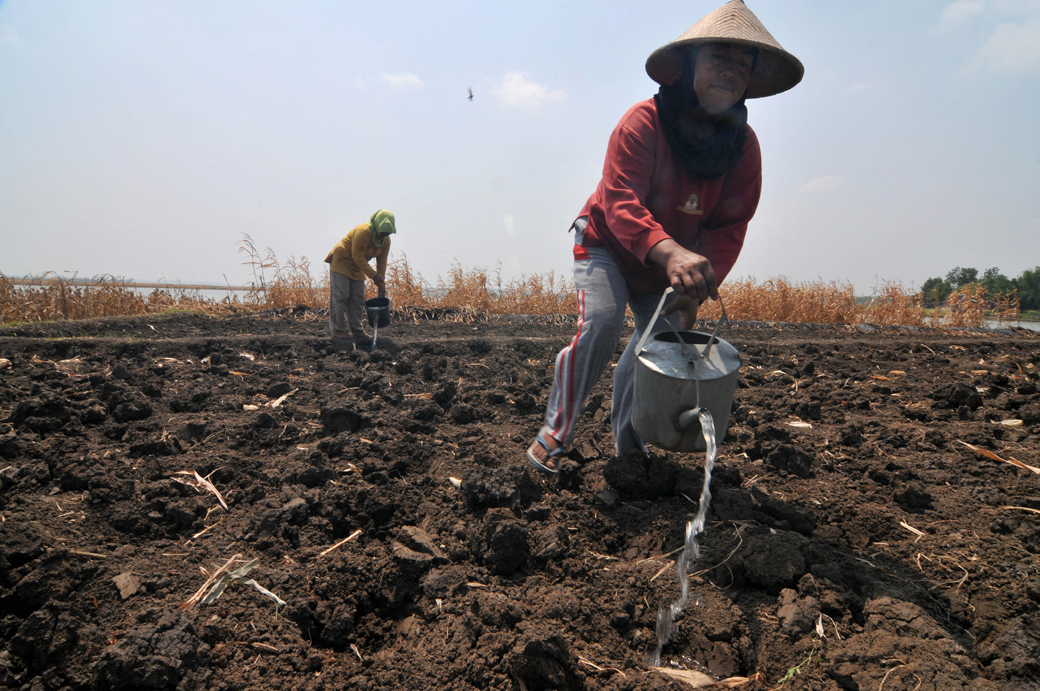
A farmer pours water on dry land in order to plant corn in Boyolali, Central Java, Indonesia, on Aug. 29, 2014. (Photo by Agoes Rudianto/NurPhoto/Sipa USA)
2. Will we seek to mediate conflict?
At least two recent conflicts were sparked by extreme weather. First in Darfur, and then in Syria, drought and desertification exacerbated an already tense situation — acting as what experts call a “threat multiplier” — that boiled over into open conflict.
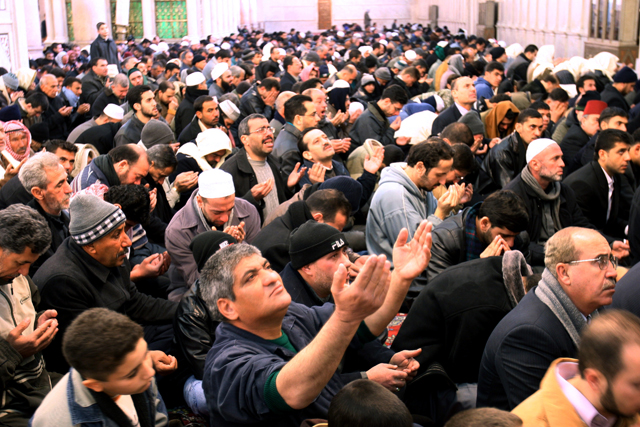
Thousands of Syrian Muslims pray for rain at the Grand Umayyad Mosque in central Damascus on Dec. 29, 2006. (AP Photo Bassem Tellawi).
But those are just two examples illustrating how severe weather — in these cases, a drought — in a volatile region can have violent consequences. Caitlin Werrell and Francesco Femia, co-directors and founders of the Center for Climate & Security, told BillMoyers.com via email that, “coupled with poor governance, [extreme drought] can mean the mass displacement of peoples, with significant consequences for regional and international security.”
“A heat wave that devastates crop production in China may result in a sharp increase in global wheat prices, potentially contributing to further instability in the Middle East and North Africa. Destabilizing floods in Pakistan, a country awash in nuclear materials and terrorist cells, could contribute to an international security disaster. And melting sea ice threatens not just polar bears, but also the geopolitical balance in the Arctic, as well as densely-populated coastlines across the globe.”
In the years ahead, these conflicts will be increasingly common, spilling across national borders and further complicating a number of already-complicated foreign policy challenges. Femia and Werrell write, “the United States will find it difficult — if not impossible — to avoid intervention in a growing number of unstable countries that present threats to regional, national and international security.
“On the other hand, tackling climate change head on, and assisting other nations in doing so responsibly, will lessen both the likelihood of instability and conflict, and the probability that the United States will be called on to intervene. In other words, an ounce of prevention is worth a pound of cure.”
3. Will we open our doors to refugees?
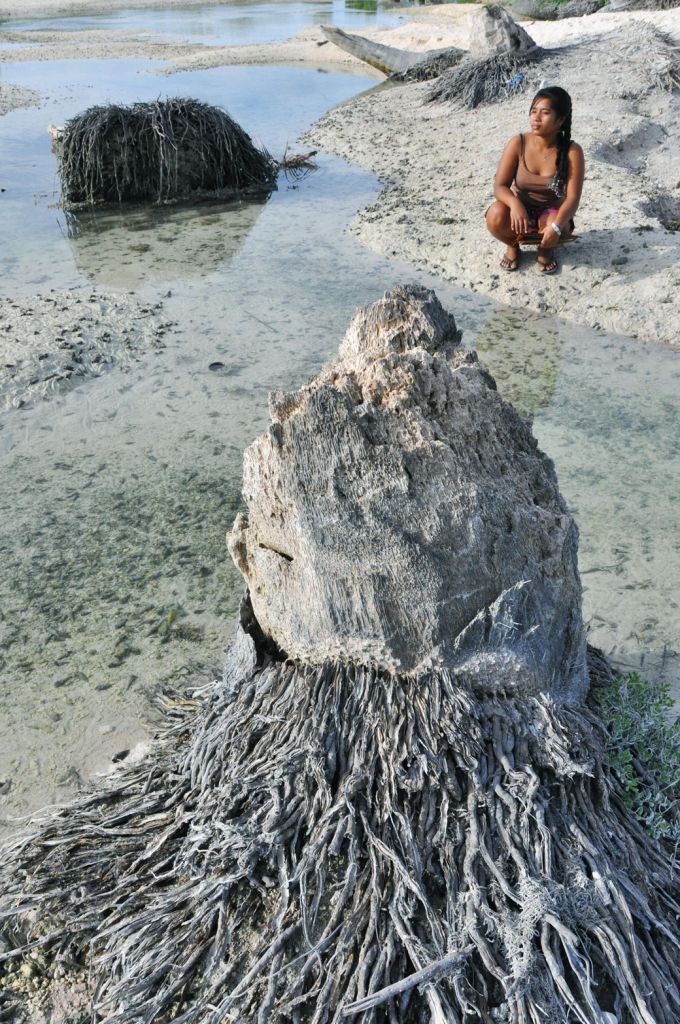
A coconut tree is withered from the impact of rising sea levels near the shore in Tarawa, Kiribati, on May 16, 2012. The South Pacific island nation is considered particularly vulnerable to global climate change. (Kyodo)
Over the course of this century, as climate change’s wide range of environmental effects — sea level rise, drought, increasingly severe storms — begins to wreak havoc on nations and their economies, hundreds of millions of people will be forced to leave their homes. Wealthy nations will need to determine if and how they want to help.
Sea level rise will be one particularly brutal agent of displacement. It threatens to completely submerge small island nations, such as Kiribati and the Maldives, and to dramatically affect larger ones like the Philippines. Sea water will also surge through low-lying agricultural land in nations such as Bangladesh and Vietnam, forcing farmers to relocate.
The residents of a handful of nations would be allowed to relocate to the US. The American government has an agreement called a Compact of Free Association (CFA) with the Marshall Islands, Micronesia and Palau, in which the US can conduct military operations among the islands — at one point in history, that meant nuclear tests in the region — in exchange for including them in some domestic programs and providing protection. Through the CFA agreement, citizens of these islands are allowed to come work and live in the US.
America can also grant “Temporary Protected Status” (TPS) to the people of a particular nation that went through an environmental disaster, like the earthquake that struck Haiti in 2010. But there’s no guarantee it will. The agency responsible, Citizen and Immigration Services, has not, for instance, provided protected status to refugees from Typhoon Haiyan, which decimated the Philippines. Furthermore, TPS is by nature temporary, and those displaced by climate change would be looking for a permanent home.
Climate change-displaced persons are also not currently able to apply for residency in the US as a refugee. The legal definition of “refugee” applies only to those who are fleeing persecution or the threat of persecution, said Michael Gerrard, Director of the Sabin Center for Climate Change Law and a professor at Columbia University Law School. “There’s a lot of discussion in academic circles about whether to create some kind of new, international category of climate-displaced people,” he says. “But there are not yet any official negotiations going on, much less agreements.”
4. Are we liable for these disasters?
Lets say you have a rich neighbor. He decides one night to have a party with a big bonfire. It’s a success; his guests are having fun. Gradually, the fire gets out of control, but your neighbor’s guests keep tossing logs on. The fire spreads, and burns down your house. You might reasonably ask this neighbor to compensate you for the damages he caused, right?
It’s an apt metaphor for the scenario playing out on a global scale: Our planet’s wealthy nations have fossil fuel habits that have sent the world’s climate spinning out of control. Many activists from poorer nations argue that the damage developed nations have caused should be compensated for in some way. The UN refers to this idea as “loss and damage.”
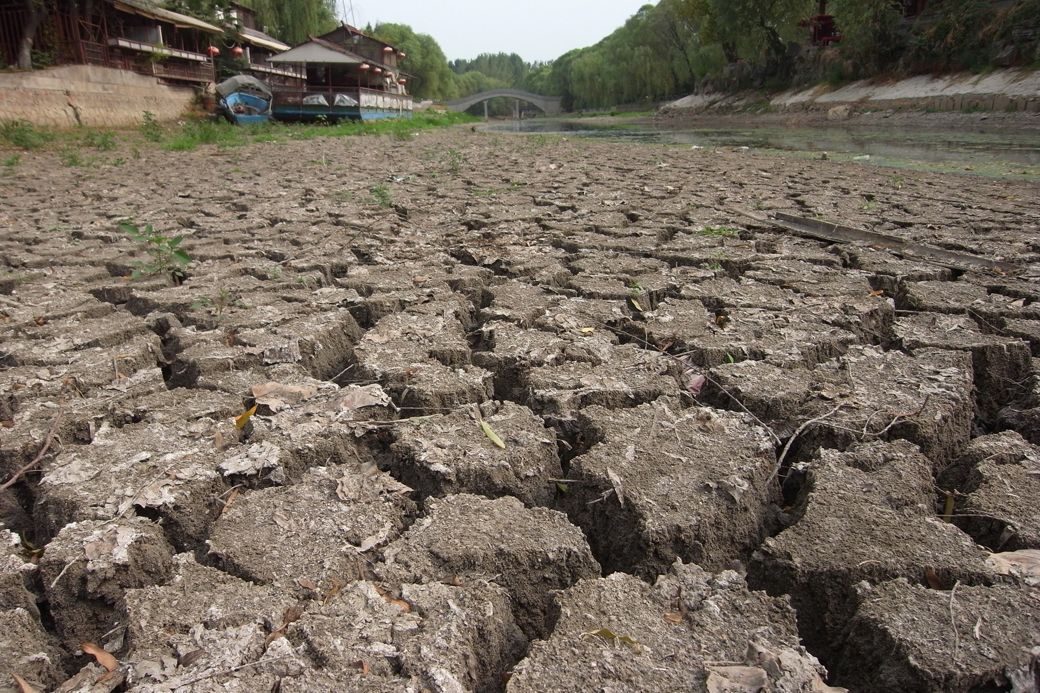
View of the cracked bed of the nearly dried-up Qingni River during a drought in Xuchang City, central China’s Henan province, July 29, 2014.
“Climate change at its heart reveals the still stark divides in resources, development paths and emissions contributions between rich and poor nations, and rich and poor people within those nations,” says Desmond D’Sa, a South African environmental and social justice organizer, who is in New York for the People’s Climate March. “The disparities between the rich developed countries and poor developing and underdeveloped countries are widening and need to be looked at in careful consideration.”
Colin Rajah, a Malaysian climate activist and the International Coordinator of the Global Coalition on Migration, who will also be joining the People’s Climate March on Sunday, tells BillMoyers.com, “The UN, as a world body, has the capacity to enact international policies to hold the polluting countries accountable, and offer resources to impacted countries. But the UN lacks any political will to do this and continues to flirt with and tout false solutions while continuing to allow the wide-scale extraction and burning of fossil fuels and other carbon emissions.”
Columbia University’s Michael Gerrard suggests the impasse is not likely to change soon. “The problem is, [loss and damage] is supported by the countries that would receive the money, but I’m not aware that it’s supported by any of the countries that would give out the money. They make a compelling moral case, but they have no ability to force the developed countries to go along.”
5. How can we change course?
In addition to reigning in our own emissions, many poorer countries are looking to wealthier countries to help facilitate a global shift toward sustainable energy.
“Developed countries have a historical responsibility — we have common responsibly as well — but developed countries have historical responsibilities to drastically reduce emissions and to contribute to solving the problem of climate change,” says Peru’s Juan Pedro Chang. “They need to help other countries transition from systems and models that rely on fossil fuels to models that work and rely on clean energy.”
After this month’s UN summit in New York City, the Conference of Parties (COP) 20 will be held in Lima, Peru, in December. Many experts point to the summit after that, the November 2015 Paris conference, as the last chance for the world to settle on an agreement to meet the target — no more than 2 degrees Celsius of warming — that the IPCC says is necessary to avert catastrophic climate change.
These summits will be opportunities to hammer out the sort of long-sought-after international climate treaty that activists have been hoping for, and that treaty could include measures to help poorer countries develop economies fueled by sustainable energy. “What we expect out of a COP20 in Lima is a draft agreement that incorporates a demand for climate justice and a just transition program,” says Peru’s Juan Pedro Chang.

An aerial view showing buildings partially submerged in Srinagar, Indian-controlled Kashmir on Sept. 10, 2014. Raging monsoon floods sweeping across India and Pakistan have killed more than 500 people, authorities said. (AP Photo/Dar Yasin)
As the world waits year after year for the details of a possible climate agreement to be hammered out, international grassroots leaders, in response to questions from BillMoyers.com, made clear their frustration with the entire negotiating process, which they say is taking more time than our warming planet can afford. Meanwhile, wealthy Western nations, and newer big-time polluters like China and India, continue to spew greenhouse gasses.
“We know that the United Nations is calling for the governments around the world to meet and talk about the negotiations about climate change,” says Isso Nihmei, a youth organizer from Vanuatu, who will be representing a number of Pacific Islands threatened by climate change at the People’s Climate March. “We, as Pacific Islanders, we really don’t want talk, negotiations. We have been through that for 28 years. We want the international governments to take some action in response to the climate change issue.”
“Every year there is the UNFCCC COP, the Conference of the Parties, where policy is discussed and targets set for the scaling down of greenhouse gas emissions,” writes Ursula Rakova, an environmental organizer from the Carteret Islands, part of Papua New Guinea, which are in danger of being submerged by sea level rise. “But the destruction is already great and the targets are minimal. When exactly are they going to implement their discussions? The time is now!”
This work is licensed under a Creative Commons Attribution-NoDerivatives 4.0 International License.



